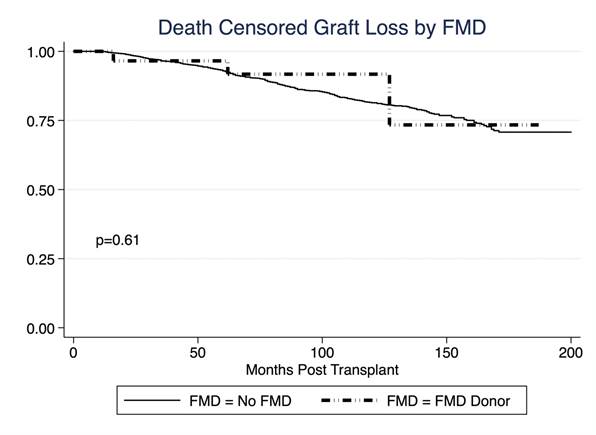Fibromuscular Dysplasia in Living Kidney Donors: Characteristics and Recipient Outcomes.
Mayo Clinic, Rochester, MN
Meeting: 2017 American Transplant Congress
Abstract number: A233
Keywords: Donation, Renal artery stenosis
Session Information
Session Name: Poster Session A: Living Donor Kidney Transplant I
Session Type: Poster Session
Date: Saturday, April 29, 2017
Session Time: 5:30pm-7:30pm
 Presentation Time: 5:30pm-7:30pm
Presentation Time: 5:30pm-7:30pm
Location: Hall D1
Introduction: Presence of incidentally detected fibromuscular dysplasia (FMD) is a challenging and controversial issue for selection of living kidney donors (LKD). Whether donors with FMD differ regarding blood pressure and kidney function after donation, and whether allograft outcomes over the long term are adversely affected are not known. We conducted a retrospective analysis of LKD with incidentally detected FMD within a single center over 15 years to determine these outcomes.
Methods: We reviewed medical records of LKD with incidental FMD during donor evaluation from January 2000 to August 2015 at a single medical center. Baseline demographics and recipient graft survival were reviewed. Donor Blood pressure (BP), iothalamate clearance (IC) and urine protein and albumin excretion rate pre and 4 months post donation were done. LKD without FMD were used for comparison.
Results: Potential LKD who underwent evaluation were 3,327. Out of those, 2250 LKD were accepted for donation, and 38 subjects were found to have incidental FMD. Incidental FMD donors were older (54.1±8.7 vs. 43±11 years, p <0.01) and predominantly female (85% vs. 57%, p<0.001); 35.2% had bilateral FMD. Initial BP, renal function by IC, urine protein and albumin excretion rate were similar between groups. FMD donors were less likely to have a decrease in nocturnal BP (46% vs 36%, p=0.007). Follow up BP, urine albumin and protein excretion rate did not differ between groups. Post donation IC was numerically lower in FMD donors when compared to other LKD (62±8.6 vs. 66±13 ml/min/1.73m2 , p=0.03); however, when adjusted for sex and age, it did not differ (p=0.25 ). Long-term recipient graft outcomes from FMD donors did not differ from recipients of non-FMD kidneys. Conclusions: These data demonstrate that LKD with FMD have similar BP, and albuminuria to non-FMD donors, with similar post donation GFR. Allograft outcomes for recipients of FMD kidneys are similar to those of all other living donors. Our results support living kidney donation from incidentally detected FMD.
Conclusions: These data demonstrate that LKD with FMD have similar BP, and albuminuria to non-FMD donors, with similar post donation GFR. Allograft outcomes for recipients of FMD kidneys are similar to those of all other living donors. Our results support living kidney donation from incidentally detected FMD.
CITATION INFORMATION: Gonzalez Suarez M, Amer H, Jaffer I, Vrtiska T, Rule A, Prieto M, Textor S. Fibromuscular Dysplasia in Living Kidney Donors: Characteristics and Recipient Outcomes. Am J Transplant. 2017;17 (suppl 3).
To cite this abstract in AMA style:
Suarez MGonzalez, Amer H, Jaffer I, Vrtiska T, Rule A, Prieto M, Textor S. Fibromuscular Dysplasia in Living Kidney Donors: Characteristics and Recipient Outcomes. [abstract]. Am J Transplant. 2017; 17 (suppl 3). https://atcmeetingabstracts.com/abstract/fibromuscular-dysplasia-in-living-kidney-donors-characteristics-and-recipient-outcomes/. Accessed December 14, 2025.« Back to 2017 American Transplant Congress
